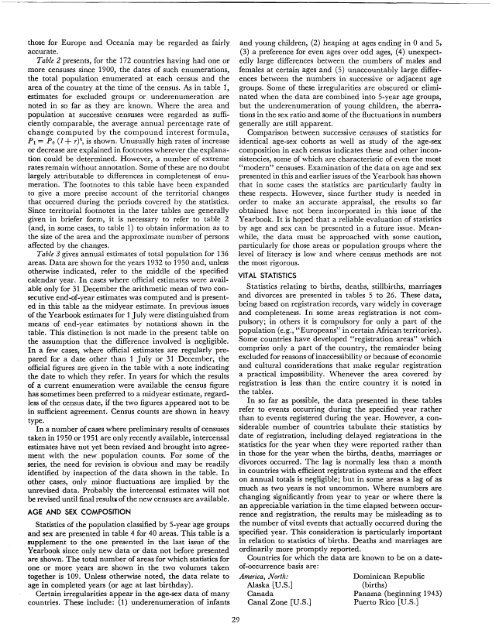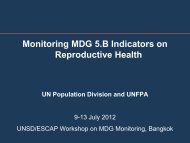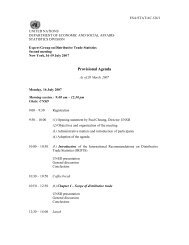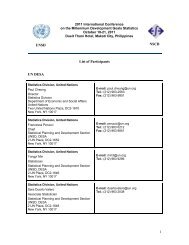demographic yearbook annuaire demographique 1951
demographic yearbook annuaire demographique 1951
demographic yearbook annuaire demographique 1951
You also want an ePaper? Increase the reach of your titles
YUMPU automatically turns print PDFs into web optimized ePapers that Google loves.
those for Europe and Oceania may be regarded as fairly<br />
accurate.<br />
Table 2 presents, for the 172 countries having had one or<br />
more censuses since 1900, the dates of such enumerations,<br />
the total population enumerated at each census and the<br />
area of the country at the time of the census. As in table 1,<br />
estimates for excluded groups or underenumeration are<br />
noted in so far as they are known. Where the area and<br />
population at successive censuses were regarded as sufficiently<br />
comparable, the average annual percentage rate of<br />
change computed by the compound interest formula,<br />
PI = Po (1 + r)t, is shown. Unusually high rates of increase<br />
or decrease are explained in footnotes wherever the explanation<br />
could be determined. However, a number of extreme<br />
rates remain without annotation. Some ofthese are no doubt<br />
largely attributable to differences in completeness of enumeration.<br />
The footnotes to this table have been expanded<br />
to give a more precise account of the territorial changes<br />
that occurred during the periods covered by the statistics.<br />
Since territorial footnotes in the later tables are generally<br />
given in briefer form, it is necessary to refer to table 2<br />
(and, in some cases, to table 1) to obtain information as to<br />
the size of the area and the approximate number of persons<br />
affected by the changes.<br />
Table 3 gives annual estimates of total population for 136<br />
areas. Data are shown for the years 1932 to 1950 and, unless<br />
otherwise indicated, refer to the middle of the specified<br />
calendar year. In cases where official estimates were available<br />
only for 31 December the arithmetic mean of two consecutive<br />
end-of-year estimates was computed and is presented<br />
in this table as the midyear estimate. In previous issues<br />
of the Yearbook estimates for 1 July were distinguished from<br />
means of end-year estimates by notations shown in the<br />
table. This distinction is not made in the present table on<br />
the assumption that the difference involved is negligible.<br />
In a few cases, where official estimates are regularly prepared<br />
for a date other than 1 July or 31 December, the<br />
official figures are given in the table with a note indicating<br />
the date to which they refer. In years for which the results<br />
of a current enumeration were available the census figure<br />
has sometimes been preferred to a midyear estimate, regardless<br />
of the census date, if the two figures appeared not to be<br />
in sufficient agreement. Census counts are shown in heavy<br />
type.<br />
In a number ofcases where preliminary results of censuses<br />
taken in 1950 or <strong>1951</strong> are only recently available, intercensal<br />
estimates have not yet been revised and brought into agreement<br />
with the new population counts. For some of the<br />
series, the need for revision is obvious and may be readily<br />
identified by inspection of the data shown in the table. In<br />
other cases, only minor fluctuations are implied by the<br />
unrevised data. Probably the intercensal estimates will not<br />
be revised until final resultil ofthe new censuses are available.<br />
AGE AND SEX COMPOSITION<br />
Statistics of the population classified by 5-year age groups<br />
and sex are presented in table 4 for 40 areas. This table is a<br />
supplement to the one presented in the last issue of the<br />
Yearbook since only new data or data not before presented<br />
are shown. The total number of areas for which statistics for<br />
one or more years are shown in the two volumes taken<br />
together is 109. Unless otherwise noted, the data relate to<br />
age in completed years (or age at last birthday).<br />
Certain irregularities appear in the age-sex data of many<br />
countries. These include: (1) underenumeration of infants<br />
and young children, (2) heaping at ages ending in 0 and 5,<br />
(3) a preference for even ages over odd ages, (4) unexpectedly<br />
large differences between the numbers of males and<br />
females at certain ages and (5) unaccountably large differences<br />
between the numbers in successive or adjacent age<br />
groups. Some of these irregularities are obscured or eliminated<br />
when the data are combined into 5-year age groups,<br />
but the underenumeration of young children, the aberrations<br />
in the sex ratio and some of the fluctuations in numbers<br />
generally are still apparent.<br />
Comparison between successive censuses of statistics for<br />
identical age-sex cohorts as well as study of the age-sex<br />
composition in each census indicates these and other inconsistencies,<br />
some of which are characteristic of even the most<br />
"modern" censuses. Examination of the data on age and sex<br />
presented in this and earlier issues ofthe Yearbook has shown<br />
that in some cases the statistics are particularly faulty in<br />
these respects. However, since further study is needed in<br />
order to make an accurate appraisal, the results so far<br />
obtained have not been incorporated in this issue of the<br />
Yearbook. It is hoped that a reliable evaluation of statistics<br />
by age and sex can be presented in a future issue. Meanwhile,<br />
the data must be approached with some caution,<br />
particularly for those areas or population groups where the<br />
level of literacy is low and where census methods are not<br />
the most rigorous.<br />
VITAL STATISTICS<br />
Statistics relating to births, deaths, stillbirths, marriages<br />
and divorces are presented in tables 5 to 26. These data,<br />
being based on registration records, vary widely in coverage<br />
and completeness. In some areas registration is not compulsory;<br />
in others it is compulsory for only a part of the<br />
population (e.g., "Europeans" in certain African territories).<br />
Some countries have developed "registration areas" which<br />
comprise only a part of the country, the remainder being<br />
excluded for reasons ofinaccessibility or because ofeconomic<br />
and cultural considerations that make regular registration<br />
a practical impossibility. Whenever the area covered by<br />
registration is less than the entire country it is noted in<br />
the tables.<br />
In so far as possible, the data presented in these tables<br />
refer to events occurring during the specified year rather<br />
than to events registered during the year. However, a considerable<br />
number of countries tabulate their statistics by<br />
date of registration, including delayed registrations in the<br />
statistics for the year when they were reported rather than<br />
in those for the year when the births, deaths, marriages or<br />
divorces occurred. The lag is normally less than a month<br />
in countries with efficient registration systems and the effect<br />
on annual totals is negligible; but in some areas a lag of as<br />
much as two years is not uncommon. Where numbers are<br />
changing significantly from year to year or where there is<br />
an appreciable variation in the time elapsed between occurrence<br />
and registration, the results may be misleading as to<br />
the number of vital events that actually occurred during the<br />
specified year. This consideration is particularly important<br />
in relation to statistics of births. Deaths and marriages are<br />
ordinarily more promptly reported.<br />
Countries for which the data are known to be on a dateof-occurrence<br />
basis are:<br />
America, North:<br />
Alaska [U.S.]<br />
Canada<br />
Canal Zone [U.S.]<br />
Dominican Republic<br />
(births)<br />
Panama (beginning 1943)<br />
Puerto Rico [U.S.]<br />
29













